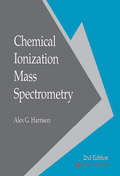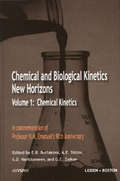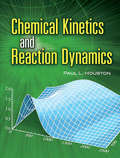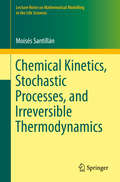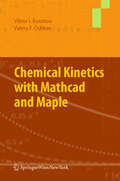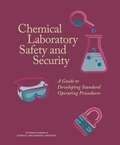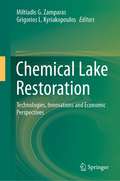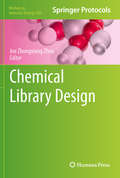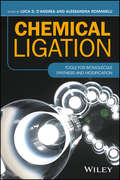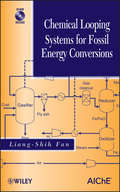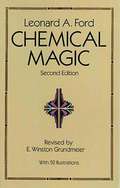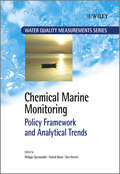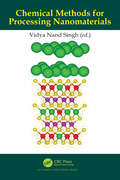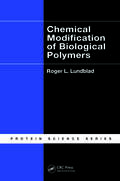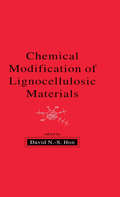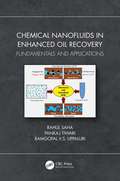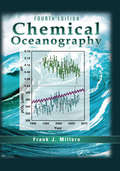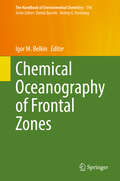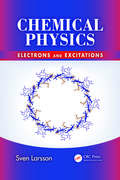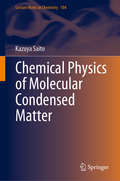- Table View
- List View
Chemical Ionization Mass Spectrometry
by Alex. G. HarrisonThe only comprehensive guide to CIMS applications in structural elucidation and analytical studiesChemical Ionization Mass Spectrometry, 2nd Edition, provides a comprehensive, up-to-date review of CIMS applications in structural elucidation and quantitative analytical studies. For the benefit of readers without a background in gaseous ion chemistry, a thorough review is presented in Chapter 2. Other chapters discuss such topics as reagent ion systems within the context of the thermochemistry and kinetics of the ionization process, including reactions and the type of information obtained; isotopic exchange reactions; stereochemical effects in chemical ionization; and reactive ion/molecule collisions in quadrupole cells. Chemical ionization mass spectra of 13 classes of compounds are discussed in detail to illustrate the influence of different functional groups on the spectra observed. Chemical Ionization Mass Spectrometry, 2nd Edition will be a valuable reference for anyone interested in mass spectrometry and gaseous ion chemistry in general.
Chemical kinetics
by E. Yu KharitonovaThe volume is devoted to the problem of chemical kinetics on modern level. The book includes information on chemical physics of nanocomposites, degradation, stabilization and flammability of polymeric materials as well as free radical mechanism of oxidation of organic compounds, thermostability, mechanism of action of catalytical systems and inhibi
Chemical Kinetics and Process Dynamics in Aquatic Systems
by PatrickL. BrezonikChemical Kinetics and Process Dynamics in Aquatic Systems is devoted to chemical reactions and biogeochemical processes in aquatic systems. The book provides a thorough analysis of the principles, mathematics, and analytical tools used in chemical, microbial, and reactor kinetics. It also presents a comprehensive, up-to-date description of the kinetics of important chemical processes in aquatic environments. Aquatic photochemistry and correlation methods (e.g., LFERs and QSARs) to predict process rates are covered. Numerous examples are included, and each chapter has a detailed bibliography and problems sets. The book will be an excellent text/reference for professionals and students in such fields as aquatic chemistry, limnology, aqueous geochemistry, microbial ecology, marine science, environmental and water resources engineering, and geochemistry.
Chemical Kinetics and Reaction Dynamics (Dover Books on Chemistry)
by Paul L. HoustonThis text teaches the principles underlying modern chemical kinetics in a clear, direct fashion, using several examples to enhance basic understanding. It features solutions to selected problems, with separate sections and appendices that cover more technical applications.Each chapter is self-contained and features an introduction that identifies its basic goals, their significance, and a general plan for their achievement. This text's important aims are to demonstrate that the basic kinetic principles are essential to the solution of modern chemical problems, and to show how the underlying question -- "How do chemical reactions occur?" -- leads to exciting, vibrant fields of modern research. The first aim is achieved by using relevant examples in presenting the basic material, and the second is attained by inclusion of chapters on surface processes, photochemistry, and reaction dynamics.
Chemical Kinetics, Stochastic Processes, and Irreversible Thermodynamics (Lecture Notes on Mathematical Modelling in the Life Sciences)
by Moisés SantillánThis book brings theories in nonlinear dynamics, stochastic processes, irreversible thermodynamics, physical chemistry and biochemistry together in an introductory but formal and comprehensive manner Coupled with examples, the theories are developed stepwise, starting with the simplest concepts and building upon them into a more general framework Furthermore, each new mathematical derivation is immediately applied to one or more biological systems The last chapters focus on applying mathematical and physical techniques to study systems such as: gene regulatory networks and molecular motors. The target audience of this book are mainly final year undergraduate and graduate students with a solid mathematical background (physicists, mathematicians and engineers), as well as with basic notions of biochemistry and cellular biology. This book can also be useful to students with a biological background who are interested in mathematical modeling and have a working knowledge of calculus, differential equations and a basic understanding of probability theory.
Chemical Kinetics with Mathcad and Maple
by Valery Ochkov Viktor KorobovThe authors explain at length the principles of chemical kinetics and approaches to computerized calculations in modern software suites -- mathcad and maple. Mathematics is crucial in determining correlations in chemical processes and requires various numerical approaches. Often significant issues with mathematical formalizations of chemical problems arise and many kinetic problems can´t be solved without computers. Numerous problems encountered in solving kinetics´ calculations with detailed descriptions of the numerical tools are given. Special attention is given to electrochemical reactions, which fills a gap in existing texts not covering this topic in detail. The material demonstrates how these suites provide quick and precise behavior predictions for a system over time (for postulated mechanisms).Examples, i.e., oscillating and non-isothermal reactions, help explain the use of mathcad more efficiently. Also included are the results of authors' own research toward effective computations.
Chemical Laboratory Safety and Security: A Guide to Developing Standard Operating Procedures
by Engineering Medicine National Academies of SciencesThe U.S. Department of State charged the Academies with the task of producing a protocol for development of standard operating procedures (SOPs) that would serve as a complement to the Chemical Laboratory Safety and Security: A Guide to Prudent Chemical Management and be included with the other materials in the 2010 toolkit. To accomplish this task, a committee with experience and knowledge in good chemical safety and security practices in academic and industrial laboratories with awareness of international standards and regulations was formed. The hope is that this toolkit expansion product will enhance the use of the previous reference book and the accompanying toolkit, especially in developing countries where safety resources are scarce and experience of operators and end-users may be limited.
Chemical Lake Restoration: Technologies, Innovations and Economic Perspectives
by Miltiadis G. Zamparas Grigorios L. KyriakopoulosThis book aims to structure, in a complete and sequential way, the mainstream technical knowledge which is related to eutrophication control. The book considers the development of innovative technologies for phosphate removal, while supporting the restoration of currently degraded lakes and reservoir systems. In addition, this book contains key-aspects of future benchmark interests being specially framed under the ongoing development of a circular economy. In particular, the book will contribute to a better understanding of the problem of internal P-loads and P-sources disposition towards a more effective control of nutrients’ enrichment in lakes. The chemical routes and environmental fate of such lake nutrients will be viewed in the light of innovative technologies (engineering dimensions) and circular economy perspectives (economics dimensions). The main theme extends to an economic appreciation of environmental polluted aquifers. The book will appeal to an interdisciplinary audience, covering a wide spectrum of scientific fields, such as environment, physical chemistry, surface chemistry, interfacial phenomena, coastal engineering, bio-engineering, environmental policy makers, and economists.
Chemical Library Design (Methods in Molecular Biology #685)
by Joe Zhongxiang ZhouChemical library technologies have brought about dramatic changes in the drug discovery process, and, though still evolving, they have become an integral part of ongoing drug discovery research. In Chemical Library Design, experts in the field provide methods and detailed protocols delving into this key process of selecting useful, biologically relevant compounds from large pools of synthesizable candidates. This compendium includes chapters on historical overviews, state-of-the-art methodologies, including structure-based and fragment-based library design, practical software tools, and successful and important applications of chemical library design. As a volume in the popular Methods in Molecular BiologyTM series, the thorough contributions provide the kind of meticulous description and implementation advice that is crucial for getting optimal results. Authoritative and cutting-edge, Chemical Library Design is an ideal reference for all scientists seeking the technology needed to aid in the search for new and vital drugs.
Chemical Ligation: Tools for Biomolecule Synthesis and Modification
by Alessandra Romanelli Luca D. D'AndreaPresenting a wide array of information on chemical ligation – one of the more powerful tools for protein and peptide synthesis – this book helps readers understand key methodologies and applications that protein therapeutic synthesis, drug discovery, and molecular imaging.• Moves from fundamental to applied aspects, so that novice readers can follow the entire book and apply these reactions in the lab• Presents a wide array of information on chemical ligation reactions, otherwise scattered across the literature, into one source• Features comprehensive and multidisciplinary coverage that goes from basics to advanced topics• Helps researchers choose the right chemical ligation technique for their needs
Chemical Looping Systems for Fossil Energy Conversions
by Liang-Shih FanThis book presents the current carbonaceous fuel conversion technologies based on chemical looping concepts in the context of traditional or conventional technologies. The key features of the chemical looping processes, their ability to generate a sequestration-ready CO2 stream, are thoroughly discussed. Chapter 2 is devoted entirely to the performance of particles in chemical looping technology and covers the subjects of solid particle design, synthesis, properties, and reactive characteristics. The looping processes can be applied for combustion and/or gasification of carbon-based material such as coal, natural gas, petroleum coke, and biomass directly or indirectly for steam, syngas, hydrogen, chemicals, electricity, and liquid fuels production. Details of the energy conversion efficiency and the economics of these looping processes for combustion and gasification applications in contrast to those of the conventional processes are given in Chapters 3, 4, and 5.Finally, Chapter 6 presents additional chemical looping applications that are potentially beneficial, including those for H2 storage and onboard H2 production, CO2 capture in combustion flue gas, power generation using fuel cell, steam-methane reforming, tar sand digestion, and chemicals and liquid fuel production. A CD is appended to this book that contains the chemical looping simulation files and the simulation results based on the ASPEN Plus software for such reactors as gasifier, reducer, oxidizer and combustor, and for such processes as conventional gasification processes, Syngas Chemical Looping Process, Calcium Looping Process, and Carbonation-Calcination Reaction (CCR) Process. Note: CD-ROM/DVD and other supplementary materials are not included as part of eBook file.
Chemical Magic
by Leonard A. FordFor many years, Leonard A. Ford, formerly Chairman of the Division of Science and Mathematics at Mankato State College, Minnesota, devised "chemical magic" shows for a series of college science fairs. In response to many requests, he compiled a volume of over 100 novel demonstrations from those shows. The book soon became one of the most widely used manuals in the field. Its tricks, mystifying and often spectacular, were designed not only to amuse and entertain an audience but to stimulate an interest in scientific principles.Now, with this revised and enlarged republication of Dr. Ford's classic guide, students at both high school and college levels can learn to perform a wide variety of entertaining and educational chemical magic. Here is a dazzling array of stunts and demonstrations dealing with gas liberation, color changes, fires and combustion, smoke and vapors, polymerization, specific gravity, crystallization and precipitation, and many other chemical processes. Professor Ford provides clear and careful explanations for creating cold fire, a disappearing flame and dust explosions; dissolving a glass in water; turning water to milk and back again to water; producing mysterious balloons, heavy air, and magical eggs; and carrying out scores of other intriguing "tricks" with materials available in almost any school laboratory, supply house, or home. Training and experience in handling chemicals are required for the performance of these demonstrations. Dr. Ford outlines directions and safety precautions for each trick. In addition, he supplies helpful suggestions for a line of "patter" to use during performances.Newly revised and updated by Professor E. Winston Grundmeier, this absorbing and unusual book will be welcomed by science educators at the high school and college levels as well as by sponsors of youth and church groups, service clubs, science fairs, and other organizations.
Chemical Marine Monitoring: Policy Framework and Analytical Trends (Water Quality Measurements #28)
by Philippe Quevauviller Patrick Roose Gert VerreetWide- scale chemical monitoring programmes are required by international conventions and European Union policies such as the Water Framework Directive (2000/60/EC) and the new EU Marine Strategy Framework Directive (MSFD). This entails all waters, including transitional and coastal waters, sediments and biota. The final volume in the Water Quality Measurement Serieshighlights policy frameworks and analytical trends with an emphasis on laboratory methods and quality control. Within this comprehensive text, the following sections are included: Setting the Scene; monitoring of pollutants Policy Settings; international conventions and EU marine strategy Marine monitored parameters; trace elements, chemical species, organic micropollutants, and nutrients Types of monitoring; classical chemical monitoring, biomonitoring and in-situ methods Quality assurance; certified reference materials for marine monitoring Research and developments; the role of sediments in coastal monitoring, and passive sampling technologies Chemical Marine Monitoring: Policy Framework and Analytical Trends is intended for postgraduates and researchers working in analytical chemistry and its application to environmental and health analyses. Those interested in developing new methods and materials in relation to drinking water regulations with also find this book beneficial.
Chemical Matter: Activity Book (Amplify Core Knowledge Language Arts, Grade 5 #Unit 9)
by Amplify EducationNIMAC-sourced textbook
Chemical Methods for Processing Nanomaterials
by Vidya Nand SinghThis book discusses the latest advancements in the processing of various types of nanomaterials. The main objective of the book is to provide the reader with a comprehensive review of the latest advances in synthesis as well as processing of almost all kinds of nanomaterials using various physical and chemical methods. The book includes chapters on Chemical Methods such as microemulsions, colloidal route, wet chemical method, chemical vapor deposition technique, sol-gel method, electrodeposition for growing different kinds of nanomaterials including Chalcogenides, Metal Oxide nanostructures, perovskite nanocrystals, nano structures on patterned electrode, Low Dimensional Carbon Nanomaterials and applications at Nanoscale.
Chemical Modification of Biological Polymers
by Roger L. LundbladExamining the chemical modification of biological polymers and the emerging applications of this technology, Chemical Modification of Biological Polymers reflects the change in emphasis in this subsection of biotechnology from the study of protein structure and function toward applications in therapeutics and diagnostics. HighlightsThe basic organi
Chemical Modification of Lignocellulosic Materials
by David N.-S. HonThis volume emphasizes the growing need for wood products with advanced engineering properties. It details the fundamental principles of cellulose technology and presents current techniques to modifying the basic chemistry of lignocellulosic materials. The work: discusses the cost-efficient use of cellulose derivatives in a variety of commodities; highlights the chemical modification of wood by methods such as etherification, esterification and thermoplasticization; considers recent progress in the lignocellulosic liquefaction of wood; and more.
Chemical Nanofluids in Enhanced Oil Recovery: Fundamentals and Applications
by Rahul Saha Pankaj Tiwari Ramgopal V.S. UppaluriSustainable world economy requires a steady supply of crude oil without any production constraints. Thus, the ever-increasing energy demand of the entire world can be mostly met through the enhanced production from crude oil from existing reservoirs. With the fact that newer reservoirs with large quantities of crude oil could not be explored at a faster pace, it will be inevitable to produce the crude oil from matured reservoirs at an affordable cost. Among alternate technologies, the chemical enhanced oil recovery (EOR) technique has promising potential to recover residual oil from matured reservoirs being subjected to primary and secondary water flooding operations. Due to pertinent complex phenomena that often have a combinatorial role and influence, the implementation of chemical EOR schemes such as alkali/surfactant/polymer flooding and their combinations necessitates upon a fundamental understanding of the potential mechanisms and their influences upon one another and desired response variables. Addressing these issues, the book attempts to provide useful screening criteria, guidelines, and rules of thumb for the identification of process parametric sets (including reservoir characteristics) and response characteristics (such as IFT, adsorption etc.,) that favor alternate chemical EOR systems. Finally, the book highlights the relevance of nanofluid/nanoparticle for conventional and unconventional reservoirs and serves as a needful resource to understand the emerging oil recovery technology. Overall, the volume will be of greater relevance for practicing engineers and consultants that wish to accelerate on field applications of chemical and nano-fluid EOR systems. Further, to those budding engineers that wish to improvise upon their technical know-how, the book will serve as a much-needed repository.
Chemical Neurobiology: Methods and Protocols (Methods in Molecular Biology #995)
by Matthew R. BanghartMany advances in modern neuroscience are enabled by the availability of chemical tools that allow sensitive, precise, and quantitative measurements of, and control over, biological processes. These powerful reagents are widely used for investigating the nervous system at levels of detail ranging from ion channel structure to neural network dynamics. Recent advances in photochemistry, microscopy, and protein engineering have triggered a surge in the development and application of these interdisciplinary techniques. Chemical Neurobiology: Methods and Protocols assists with the design, characterization and validation of new chemical tools for neurobiology by providing detailed protocols of procedures and assays deemed essential for the successful development and implementation of such tools. Divided into three sections, topics cover chemical probes of membrane protein structure and function, photochemical control of protein and cellular function, and chemical probes for imaging in the nervous system. Written in the successful Methods in Molecular BiologyTM series format, chapters include introductions to their respective topics, lists of the necessary materials and reagents, step-by-step, readily reproducible protocols, and notes on troubleshooting and avoiding known pitfalls. Authoritative and easily accessible, Chemical Neurobiology: Methods and Protocols serves scientists at many levels, including students aiming to expand their perspective, laboratory researchers seeking technical guidance, and established investigators looking for creative solutions to their research problems in molecular, cellular and systems neuroscience.
Chemical Oceanography: Volume 5, Chemical Oceanography (Harte Research Institute For Gulf Of Mexico Studies Series, Sponsored By The Harte Research Institute For Gulf Of Mexico Studies, Texas A&m University-corpus Christi Ser.)
by Frank J. MilleroOver the past ten years, a number of new large-scale oceanographic programs have been initiated. These include the Climate Variability Program (CLIVAR) and the recent initiation of the Geochemical Trace Metal Program (GEOTRACES). These studies and future projects will produce a wealth of information on the biogeochemistry of the world's oceans. Aut
Chemical Oceanography of Frontal Zones (The Handbook of Environmental Chemistry #116)
by Igor M. BelkinThis book is a unique and authoritative review of chemical fronts in the world ocean. It includes regional chapters on chemical fronts in all major oceans (Atlantic, Indian, Pacific, Arctic, and Southern) and marginal seas (North Sea, Baltic Sea, Mediterranean Sea, Gulf of Mexico, Yellow Sea, and the East Siberian Sea). Thematic chapters focus on diverse topics such as cross-frontal transfer of nutrients; diapycnal mixing and its impact on nutrient fluxes in western boundary currents (Gulf Stream and Kuroshio); front-driven physical-biogeochemical-ecological interactions; dynamics of coloured dissolved organic matter; pollutant concentration and fish contamination in frontal zones; distribution of microplastics in the ocean, and Lagrangian methods to study the transport of marine litter. This volume will appeal to a broad audience, including researchers, instructors, students, and practitioners of all kinds involved in scientific and applied research, environment protection and conservation, and maritime industries including fisheries, aquaculture, and mining.
The Chemical Philosophy (Dover Books on Chemistry)
by Allen G. DebusSwiss-born physician and alchemist Paracelsus (1493-1541) and his disciples espoused a doctrine they proclaimed as a truly Christian interpretation of nature in chemistry. Drawing upon a mixture of ancient, medieval, and Renaissance sources, they developed a new philosophy that interpreted both macrocosmic and microcosmic events through the personal observations of the chemist and the Divine Grace of the Lord. Until the publication of this book, however, the breadth and vicissitudes of the Paracelsian approach to nature and medicine had been little studied. This volume spans more than a century, providing a rich record of the major interests of the Paracelsian and other chemical philosophers and the conflicts in which they engaged with their contemporaries. It examines chemistry and nature in the Renaissance, the Paracelsian debates, the theories of Robert Fludd, the Helmontian restatement of the chemical philosophy, and many other issues of this transitional era in the history of science. Enhanced with 36 black-and-white illustrations, this well-researched and compellingly related study will fascinate students of the history of science, chemistry, and medicine.
Chemical Physics: Electrons and Excitations
by Sven LarssonA full understanding of modern chemistry is impossible without quantum theory. Since the advent of quantum mechanics in 1925, a number of chemical phenomena have been explained, such as electron transfer, excitation energy transfer, and other phenomena in photochemistry and photo-physics. Chemical bonds can now be accurately calculated with the hel
Chemical Physics of Molecular Condensed Matter (Lecture Notes in Chemistry #104)
by Kazuya SaitoThis book fills a gap in knowledge between chemistry- and physics-trained researchers about the properties of macroscopic (bulk) material. Although many good textbooks are available on solid-state (or condensed matter) physics, they generally treat simple systems such as simple metals and crystals consisting of atoms. On the other hand, textbooks on solid-state chemistry often avoid descriptions of theoretical background even at the simplest level. This book gives coherent descriptions from intermolecular interaction up to properties of condensed matter ranging from isotropic liquids to molecular crystals. By omitting details of specific systems for which comprehensive monographs are available—on liquid crystals and molecular conductors, for instance—this book highlights the effects of molecular properties, i.e., the presence of the shape and its deformation on the structure and properties of molecular systems.
Chemical Physics of Nanostructured Semiconductors
by Alexander I. Kokorin Detlef BahnemannDeep and detailed discussions on chemistry, chemical physics, photoelectrochemistry, photophysics, photocatalysis and possible applications of nanostructured semiconductor materials have shown increasing interest in the matter by scientists representing various research areas as well as industrial enterprises. Indeed, solar energy conversion and ch
